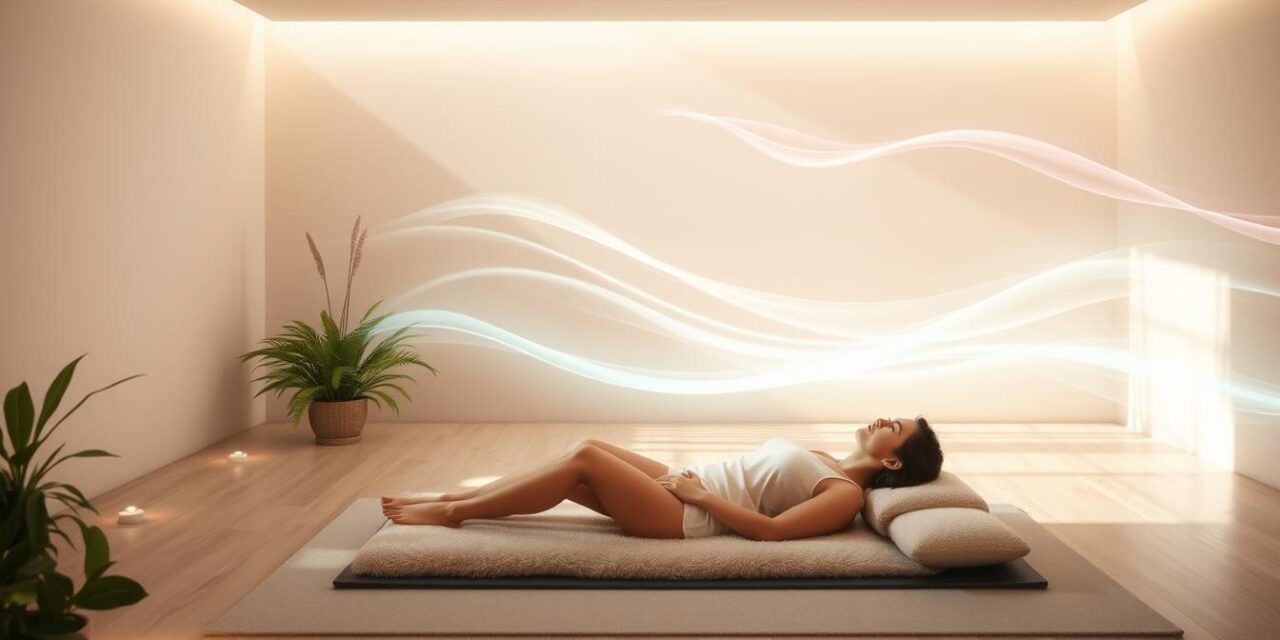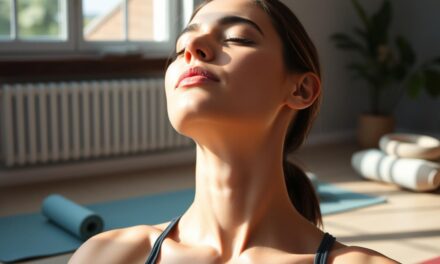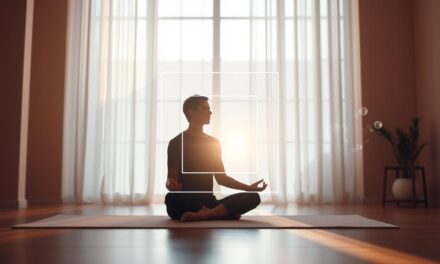In Australia, 3.2 million people deal with anxiety or depression. This shows we need good ways to handle stress. Progressive muscle relaxation is one method that can help calm the mind and lower stress levels. By adding it to our daily routine, we can see big improvements in our mental health.
Progressive muscle relaxation is a simple yet effective method. It involves tightening and then relaxing different muscle groups. This can help us feel more calm and less stressed. It also improves sleep and reduces anxiety, making it a great way to boost our wellbeing.
Key Takeaways
- Progressive muscle relaxation is a technique used to calm the mind and reduce stress
- Regular practice can lead to improved sleep quality and reduced anxiety
- Progressive muscle relaxation is a natural and non-invasive stress relief technique
- It involves tensing and relaxing different muscle groups
- Progressive muscle relaxation can be practiced daily for enhanced wellbeing
- It is an attractive option for those seeking a natural approach to managing stress
Understanding Progressive Muscle Relaxation
Progressive muscle relaxation helps manage stress and anxiety by releasing physical tension. It involves exercises to relax different muscle groups. This promotes calm and well-being.
By practicing this, people can learn to release muscle tension. This leads to less stress and anxiety.
This technique is based on the idea that physical tension causes stress and anxiety. By releasing this tension, people can feel better. They might sleep better and feel more relaxed overall.
Tension release therapy, like progressive muscle relaxation, is effective. It can be used with other techniques like deep breathing and meditation.
Regular practice of progressive muscle relaxation offers many benefits. It improves emotional control and self-awareness. It also increases feelings of calm.
By adding this to their daily routine, people can better manage stress and anxiety. This leads to better health and well-being. It’s easy to do anywhere, anytime.
Some key benefits of progressive muscle relaxation include:
- Reduced muscle tension and pain
- Improved sleep quality
- Enhanced emotional regulation
- Increased feelings of relaxation and calm
Practicing progressive muscle relaxation can greatly improve life quality. It’s a powerful tool for managing stress and promoting relaxation, whether used alone or with other techniques.
The Benefits of Regular Practice
Regular practice of progressive muscle relaxation can greatly improve your health. It can help reduce stress and anxiety. It also leads to better sleep and overall well-being.
This method helps you control your body’s stress response. It leads to a more balanced life. It’s a great way to manage anxiety.
Deep muscle relaxation is a big part of this practice. It helps release physical tension and promotes relaxation. It’s especially good for those dealing with chronic stress or anxiety.
By practicing regularly, you become more aware of your body. You can better recognize and manage stress triggers. This self-awareness is key to handling stress.
- Reduced symptoms of anxiety and depression
- Improved sleep quality and duration
- Enhanced overall well-being and quality of life
- Increased ability to manage stress and anxiety
Adding progressive muscle relaxation to your daily routine can bring many benefits. It’s a simple yet effective way to improve your health. You can do it anywhere, anytime, making it perfect for busy lives.
Essential Prerequisites for Progressive Muscle Relaxation
Before starting progressive muscle relaxation, it’s crucial to get your environment right. Knowing the best conditions for practice helps you relax better. This makes the relaxation response technique more effective.
Think about lighting, temperature, and noise levels for a good environment. A quiet, dim room with a comfy temperature is perfect for relaxation.
Creating the Right Environment
Find a quiet spot for practice, away from distractions. Using calming music or nature sounds can also help create a peaceful atmosphere.
Optimal Time of Day for Practice
The best time for relaxation is early morning or before bed. These times are when your body and mind are most relaxed.
Recommended Duration and Frequency
Begin with short sessions, 10-15 minutes, and increase as you get used to it. Practice regularly, aiming for 2-3 times a week. Daily practice is best for the best results.
Step-by-Step Progressive Muscle Relaxation Technique
Start by finding a quiet, comfy spot to sit or lie down. This helps you focus on relaxing and feel stress melt away. Begin by tensing your toes, holding for a few seconds, and then letting go. Feel the relaxation spread through your toes as you release.
Then, move up your body, tensing and relaxing each muscle group. This includes your feet, calves, thighs, hips, back, shoulders, arms, hands, neck, and head. Breathe deeply and slowly, letting the technique calm your mind. Pay attention to any tension or relaxation in your body.

- Start with small muscle groups and work your way up to larger areas
- Hold each muscle group for a few seconds before releasing
- Focus on your breath and the sensations in your body
- Practice regularly to achieve the best results from the muscle relaxation technique and stress relief
By following these steps and tips, you can use progressive relaxation to reduce stress. Regular practice can make you feel more relaxed and calm. It’s a great way to improve your well-being and add to your self-care routine.
Common Muscle Groups to Target
When you practice tension release therapy, it’s key to focus on certain muscle groups. This method helps relax muscles deeply. It’s a way to manage anxiety and boost well-being.
Start by identifying key areas to target. These include the upper body, core, lower body, and facial muscles. Knowing which areas to focus on helps relax muscles and reduce tension.
Upper Body Focus Areas
The upper body, like the neck, shoulders, and arms, often holds tension. To release this, try these steps:
- Rolling your shoulders forward and backward
- Squeezing your shoulder blades together
- Extending your arms overhead and then releasing
Core and Lower Body Regions
The core and lower body, including the abdomen, back, and legs, are also key. Techniques for relaxing these muscles include:
- Deep breathing exercises to engage the core
- Leg raises to release tension in the lower back
- Toes curls to relax the feet and ankles
Facial and Neck Muscles
The facial and neck muscles are often missed but are vital for relaxation. Techniques for releasing tension in these areas include:
- Massaging the temples and forehead
- Rolling the neck from side to side
- Smiling and then releasing to relax the facial muscles
By adding these techniques to your routine, you can enjoy deep muscle relaxation. This improves your overall well-being and helps manage anxiety effectively.
Adapting PMR for Different Situations
Progressive muscle relaxation can be done in many places. This includes meditation rooms, busy offices, or even on the way to work. It helps people find a calm mind and lower stress in their daily lives.
The relaxation response technique works in many situations. For example, during work breaks, before bed, or in stressful times like traffic jams. To use it, focus on your breath, let go of tension, and feel calm.
Here are some ways to use progressive muscle relaxation in different places:
- Do deep breathing exercises during short work breaks.
- Use guided imagery to relax before sleep.
- Listen to calming music or nature sounds while commuting.
By adding progressive muscle relaxation to your daily routine, you can handle stress and anxiety better. This leads to a more calm mind and better overall health.
Combining Progressive Muscle Relaxation with Other Relaxation Methods
Progressive muscle relaxation works better when mixed with other relaxation methods. This mix boosts the relaxation effect and helps manage stress better. You can add breathing exercises, mindfulness, and guided imagery to your routine.
Enhancing Relaxation with Breathing Exercises
Deep breathing exercises calm the mind and body. They’re great with progressive muscle relaxation. Slow, deep breaths lower stress and anxiety, leading to a relaxed state. This combo is a strong way to manage anxiety.
Mindfulness Practices for Increased Calm
Mindfulness, like meditation and yoga, pairs well with progressive muscle relaxation. These practices bring awareness and calm. They help manage stress and anxiety better. Adding mindfulness to your routine increases calm and relaxation, making it a good stress relief exercise.
Here are some mindfulness practices to mix with progressive muscle relaxation:
- Meditation: focusing on the breath or a mantra to calm the mind
- Yoga: combining physical movement with deep breathing and mindfulness
- Guided imagery: using visualization techniques to create a relaxed state
By mixing progressive muscle relaxation with these techniques, you get a better stress management approach. It’s a great way to relieve anxiety.
| Technique | Description |
|---|---|
| Breathing Exercises | Deep breathing exercises to calm the mind and body |
| Mindfulness Practices | Meditation, yoga, and guided imagery to promote awareness and calm |
| Guided Imagery | Visualization techniques to create a relaxed state |
Troubleshooting Common Challenges
When practicing progressive muscle relaxation, people might find it hard to relax some muscles or have no time to practice. Tension release therapy helps by teaching how to let go of physical tension. Finding a quiet and comfy spot to practice can solve the environment problem.
Some struggle with deep muscle relaxation. To fix this, start with short sessions and then make them longer. Remember, deep breathing and mindfulness are key to relaxing the body.

- Start with short sessions and gradually increase the duration
- Focus on deep breathing and mindfulness
- Create a quiet and comfortable practice space
By using these tips and adding tension release therapy, deep muscle relaxation, and the relaxation response technique to your routine, you can beat common hurdles. This way, you’ll reach a deeper state of calm.
Tracking Your Progress and Results
Regular practice of progressive muscle relaxation can lead to significant stress relief and a calm mind. To maximize the benefits, it’s essential to track progress and results. This can be achieved through self-assessment, physiological measures, or a combination of both.
Measuring stress reduction can be done by monitoring physical symptoms, such as heart rate and blood pressure, or by tracking emotional responses to stressful situations. Setting realistic goals is also crucial, as it helps to maintain motivation and focus. A practice journal can be a valuable tool in monitoring progress, allowing individuals to reflect on their experiences and identify areas for improvement.
Measuring Stress Reduction
- Physical symptoms: heart rate, blood pressure, and muscle tension
- Emotional responses: anxiety, mood, and overall sense of well-being
- Physiological measures: skin temperature, brain activity, and hormonal changes
By incorporating progressive muscle relaxation into their daily routine, individuals can experience a significant reduction in stress and anxiety. This leads to a calm mind and improved overall well-being. Regular practice and tracking progress can help reinforce the benefits of this stress relief exercise. It makes it an essential tool for maintaining a healthy and balanced lifestyle.
| Practice Frequency | Stress Reduction | Calm Mind |
|---|---|---|
| Daily | Significant reduction | Improved mental clarity |
| Weekly | Moderate reduction | Enhanced emotional regulation |
| Monthly | Minimal reduction | Increased self-awareness |
Conclusion: Making Progressive Muscle Relaxation Part of Your Daily Routine
Incorporating progressive muscle relaxation (PMR) into your daily routine can be very helpful. It’s a way to manage stress and anxiety. By tensing and releasing muscles, PMR calms your mind and body, leading to deep relaxation.
Regular practice of PMR offers many benefits. These include less muscle tension, better sleep, and improved emotional control. This technique can make a big difference in your life.
To get the most out of PMR, make sure to practice every day, even if it’s just for a few minutes. Being consistent is crucial. The more you do it, the more it will become a natural part of your self-care.
Remember to be patient and celebrate your progress, no matter how small. By making PMR a habit, you’ll be better equipped to handle daily stresses. It can help you feel more calm and well.






